

Login into your account
Please enter username and password bellow!
Forgotten Password
Don't have an account? Register here
Our Pharmacy Blog
Mastering pharmacy case studies.

Introduction
If you are training to become a pharmacist, you will have had experience with pharmacy case studies. But why are pharmacy case studies so important?
As a qualifying pharmacist, case studies bring together the threads of study over the past four years. This includes your study of subjects such as:
- Pharmacology
- Pharmaceutical chemistry
- Pharmaceutics
- Clinical pharmacy practice
In practice, pharmacists are expected to draw on this knowledge and clinically apply it where necessary. These subjects feed into one another where knowledge of one subject became necessary to advance in a second subject and so forth. University staff overseeing the course structure put that structure together with these factors in mind. Pharmacy case studies are an important component, often toward the end of your pharmacy degree, that aim to establish the most relevant details that play a role in the career of a qualified pharmacist.
Case studies give pharmacy students an opportunity to test their understanding of a specialist topic. This may be anything from the formulation and dosing of medicines; to a drug’s mechanism of action, drug interactions, and clinical appropriateness for a medicine in a given scenario for a patient with specific factors to keep in mind. Evidently, this takes practice. There are many possible case study scenarios to consider. It can be difficult to always get things right.
Case studies are, then, a special kind of barometer through which we measure the professional competency of pharmacy students .
That is why pharmacy case studies are popular in degree programs – forcing students to think critically about a given topic – whether it be blood diagnostics, epidemiology, treatment options, or drug monitoring – tying together their past year’s study and how to apply this knowledge to (potentially) real-life situations.
Below, we’ve put together an introductory case study to provide you with a clear example of what kinds of questions can be asked and how best you should approach each question. With enough practice, clinical case studies become that much easier. And with time, students learn to enjoy case studies – as they are often your first direct experience of learning real and relevant facts that have an impact on your long-term professional career.
Pharmacy Case Study – Osteoporosis
A 49-year old woman with osteoporosis has been taking Fosamax for 6-months. She visits her GP complaining of acid reflux and pain radiating down her esophagus.
- What is the active ingredient of Fosamax?
- What is the mechanism of action of this medicine?
- Suggest a reason why this patient is taking Fosamax.
- How should the GP respond to the patient’s symptoms?
- What foods and/or medicines should the patient avoid?
Explanation
The questions ask more about the medicine – how it works, what it’s indicated for, how the GP should respond to patient symptoms and what interactions, from both food and drug sources, the prescriber and pharmacist must consider.
A – The active ingredient of Fosamax is alendronate; a bisphosphonate drug.
B – Alendronate works by inhibiting osteoclast-mediated bone resorption (the process whereby bone is broken down and minerals are released into the blood).
C – As a 49-year old woman, the patient is likely post-menopausal. Bisphosphonates are routinely prescribed to prevent osteoporosis in these patients.
D – The patient may be improperly administering the medicine. Patients who do not follow the correct protocol of administering bisphosphonates are likely to experience specific symptoms, particularly relating to the esophagus and GI tract. Patients should be counseled to take the medicine in the morning on an empty stomach, whilst remaining upright, and taken with a full glass of water. This eases the bisphosphonate through the digestive tract without irritating the esophageal wall. Patients should avoid taking and food or medicines, both before and for at least 30-minutes after taking the bisphosphonate.
E – Two groups of medicines should be avoided. First, NSAIDs should be avoided; as they increase the risk of gastrointestinal side effects. Second, patients should avoid foods or supplements that contain multivalent ions such as magnesium, aluminum, or calcium. This category includes dairy products and antacids. As we learned above, bisphosphonates should be avoided with these medicines/foods for at least 30-minutes after the bisphosphonate has been taken (on an empty stomach).
Practice More Pharmacy Case Studies
The more pharmacy case studies you practice , the better prepared you are for the needs and demands that present during the licensing end of your pharmacy program. Pharmacy case studies help guide students through the must-know clinical facts about drugs and medicines; both theoretical and practical knowledge.
Clinical case studies are one of the ways in which students make the transition between an experienced, knowledgeable student and a clinical professional whose expertise can be trusted in the real world. Case studies bring pharmacy students to the next level. The more practice you put in, the better results you can expect as you progress through the licensing stage of your nascent career. That, in the end, is what matters.
That’s about it for our discussion of case studies! Check back to our pharmacy blog soon for more exclusive content to help you master the science of drugs and medicines and build your long-term career.
- Anticancer Pharmacology
- Antimicrobial Drugs
- Cardiovascular Pharmacology
- Clinical Case Study
- Clinical Pharmacy
- General Pharmacology
- GI Pharmacology
- Immune System Pharmacology
- Nervous System Pharmacology
- Respiratory Pharmacology
- Study Tips and Tricks
Join Our Mailing List For Even More Facts!
Don't stop learning now, you may also like, what is hartmann’s solution, must-know medicine prefixes and suffixes, tetracyclines pharmacology.

5 Interesting Medication Case Reports - Part 5
This article highlights 5 published case reports that document accidental administrations of medications following pharmacy or nursing errors.
This article is part 5 of a 6-part series on interesting and unusual medication-related case reports. For part 4 click here .
Case reports are defined as the scientific documentation of an individual patient. These reports are often written to document an unusual clinical presentation, treatment approach, side effect, or response to treatment. Most experts see case reports as the first line of evidence in health care, which can sometimes lead to future higher-level studies.
Case reports can be a great learning opportunity for both pharmacists and pharmacy students to understand a case progression and the unconventional response and effects of medications.
1. Patient harm following Norvasc error 1
Norvasc (amlodipine) is a dihydropyridine calcium channel blocker indicated for the treatment of hypertension and coronary artery disease. A case report was published in 2016 detailing an alarming and overlooked medication error involving a prescription for Norvasc.
The case report involves a recently widowed 71-year-old female who was hospitalized for uncontrolled hypertension and acute kidney injury. During the hospital stay she received temporary hemodialysis, her blood pressure medications were adjusted, and she subsequently improved clinically. Upon discharge her prescription medications included Norvasc 10 mg twice daily, metoprolol 50 mg twice daily, doxazosin 2 mg daily, and torsemide 30 mg daily.
Over the next several months, she began experiencing worsening fatigue, slow movements, personality changes, and uncontrolled blood pressure. During this time, she was hospitalized once for chest pain and had several visits to her outpatient family physician where she was diagnosed with anxiety and depression; for these she was prescribed citalopram and alprazolam. Soon after, she was rehospitalized following a fall due to light-headedness.
An admission medication reconciliation revealed that the patient was actually taking Navane (thiothixene), an antipsychotic, instead of the Norvasc. Upon further review, it was revealed the pharmacy had accidently dispensed the wrong medication despite the written prescription being fully legible. After the thiothixene was discontinued, the patient’s clinical status improvement. The authors explain how this example shows the ‘Swiss Cheese Model’ of how medication errors can occur despite interacting with multiple areas of the health care system.
2. Rythmol prescription error 2
Rythmol (propafenone) is a class 1C antiarrhythmic drug that was FDA approved in 1989. In 2010, a case report was published documenting a medication error involving a handwritten prescription for Rythmol.
The case tells the story a 73-year-old man with a history of cardiac arrhythmia who presented to the clinic for a routine follow-up visit. After being evaluated by his physician, the patient received a handwritten prescription for Rythmol 150 mg, which he had been taking for the previous 3 years. He filled this prescription with the clinic pharmacy and subsequently started to experience nausea, sweating, and an irregular heartbeat. After 2 weeks of symptoms, he called his physician for an appointment, noting that his Rythmol tablets looked different than last time.
Upon evaluation, the physician discovered that the patient incorrectly received Synthroid (levothyroxine) 150 mcg from the pharmacy instead of the prescribed Rythmol 150 mg. The pharmacist who filled the prescription attributed the error to unclear handwriting on the prescription copy. The patient’s symptoms were believed to be caused by both abrupt discontinuation of Rythmol and unnecessary use of Synthroid at a high initial dose. Once the error was corrected, the patient’s symptoms gradually resolved.
The authors explain that this error demonstrates the importance of pharmacists clarifying with physicians on prescriptions with sloppy or illegible handwriting and appropriately counseling patients on new medication therapy.
3. Accidental administration of epinephrine instead of midazolam 3
Medication errors within the inpatient setting can have severe consequences on patient harm and prolonging length of stay. This 2016 case report details a 50-year-old women who was accidentally administered epinephrine instead of midazolam during colonoscopy prep.
The patient originally presented to the hospital with a history of abdominal pain and altered bowel habits. A colonoscopy was scheduled following administration of what was believed to be midazolam 5 mg. She then started to complain of chest tightness, difficulty breathing, and generalized tremors. It was soon discovered that a medication error occurred and the patient was instead administration 0.25 mg of epinephrine instead of midazolam. The procedure was postponed for several days until the patient recovered.
A root cause of the error revealed that the epinephrine ampule was mistakenly placed in the box with the midazolam in the pharmacy following an instance where a previous patient did not require the medication. Ampules of both medications were similar in size, shape, and color. As a result, the hospital initiated new procedures to ensure regular reviews of drug containers and their contents and double checking medication names before administration.
4. Unintentional administration of insulin instead of influenza vaccine 4
In 2016, researchers published the results of an investigation where a cluster of 5 adult patients unintentionally received insulin instead of the influenza vaccine. The mix-up occurred at a public school clinic in Missouri and was discovered following an investigation from the Saint Louis County Department of Public Health. Officials learned that a school nurse inadvertently administered Humalog U-100 insulin instead of the influenza vaccine. Acute hypoglycemia was reported in all 5 patients who received the insulin with varying degrees of symptoms.
After the first 2 patients complained of sweating and lightheadedness, the nurse reported the incidents to the supervising nurse, but did not stop administering vaccines. Two later patients would require hospitalization for their symptoms, one of which was documented to have a blood glucose level of 23 mg/dL. The investigation revealed that the influenza vaccine vial was kept in the nurse’s office refrigerator along with a 10 mL vial of Humaog U-100 insulin; they were found to not be stored in separate, labeled containers or bins. The manufacturer of the influenza vaccine conducted its own analysis but found no deviations or manufacturing incidents that would suggest a quality control problem.
The study authors state this incident was likely a result of ‘confirmation bias’ where a healthcare worker may rely on familiar cues, such as the shape, colors, and markings on a vial to confirm preconceptions, which may lead to reduced vigilance and an increased risk of medication errors.
5. Warfarin and Xarelto duplication 5
Coumadin (warfarin) and Xarelto (rivaroxaban) are anticoagulants used to reduce the risk of stroke and embolism in patients with atrial fibrillation and for prophylaxis of deep vein thrombosis (DVT). A case report was recently published documenting a patient who unintentionally received both medications concurrently.
The case involves a 62-year-old man who was referred to a pharmacist-managed anticoagulation clinic for follow-up post bilateral pulmonary embolism. The patient was advised to continue on the warfarin he initiated in the hospital at a dose of 5 mg daily and return the following week for a repeat INR test. At next visit, his INR was revealed to be over 8.0. He denied taking any extra warfarin doses, recent alcohol intake, or new prescription medications. No symptoms of bruising or bleeding were noted. Upon further questioning, the patient reported starting a new medication 5 days earlier from his retail pharmacy which the clinic determined to be Xarelto 20 mg.
Investigation into the issue revealed that a prescription for Xarelto had been sent to his retail pharmacy to inquire about the cost of the medication with his insurance plan. The retail pharmacy then placed the medication on hold rather than discontinue the order entirely like the clinic staff had requested. When he visited his retail pharmacy the next day, they filled and dispensed the medication. The patient had not been counseled and assumed it was a new medication for his neuropathy. The Xarelto was subsequently discontinued and the warfarin dose was gradually reduced until the INR was within range. The case shows the importance of counseling patients on new medications and inquiring about potential duplicate therapies.
References:
- Da Silva B, Krishnamurthy M. The alarming reality of medication error: a patient case and review of Pennsylvania and National data. J Community Hosp Intern Med Perspect . 2016;6(4):10.3402/jchimp.v6.31758. doi:10.3402/jchimp.v6.31758.
- Devine B. Bad Writing, Wrong Medication. AHRQ. April 2010. Available at: https://psnet.ahrq.gov/webmm/case/215/bad-writing-wrong-medication
- Gado A, Ebeid B, Axon A. Accidental IV administration of epinephrine instead of midazolam at colonoscopy. Alexandria J of Med . 2016;62(1). doi:10.1016/j.ajme.2014.11.003.
- Clogston J, Hudanick L, Suragh TA, et al. Unintentional administration of insulin instead of influenza vaccine: a case study and review of reports to US vaccine and drug safety monitoring systems. Drugs Ther Perspect . 2016. 32: 439. doi:10.1007/s40267-016-0333-2.
- Fusco JA, Paulus EJ, Shubat AR, Miah S. Warfarin and Rivaroxaban Duplication: A Case Report and Medication Error Analysis . Drug Saf Case Rep . 2015 Dec;2(1):5.
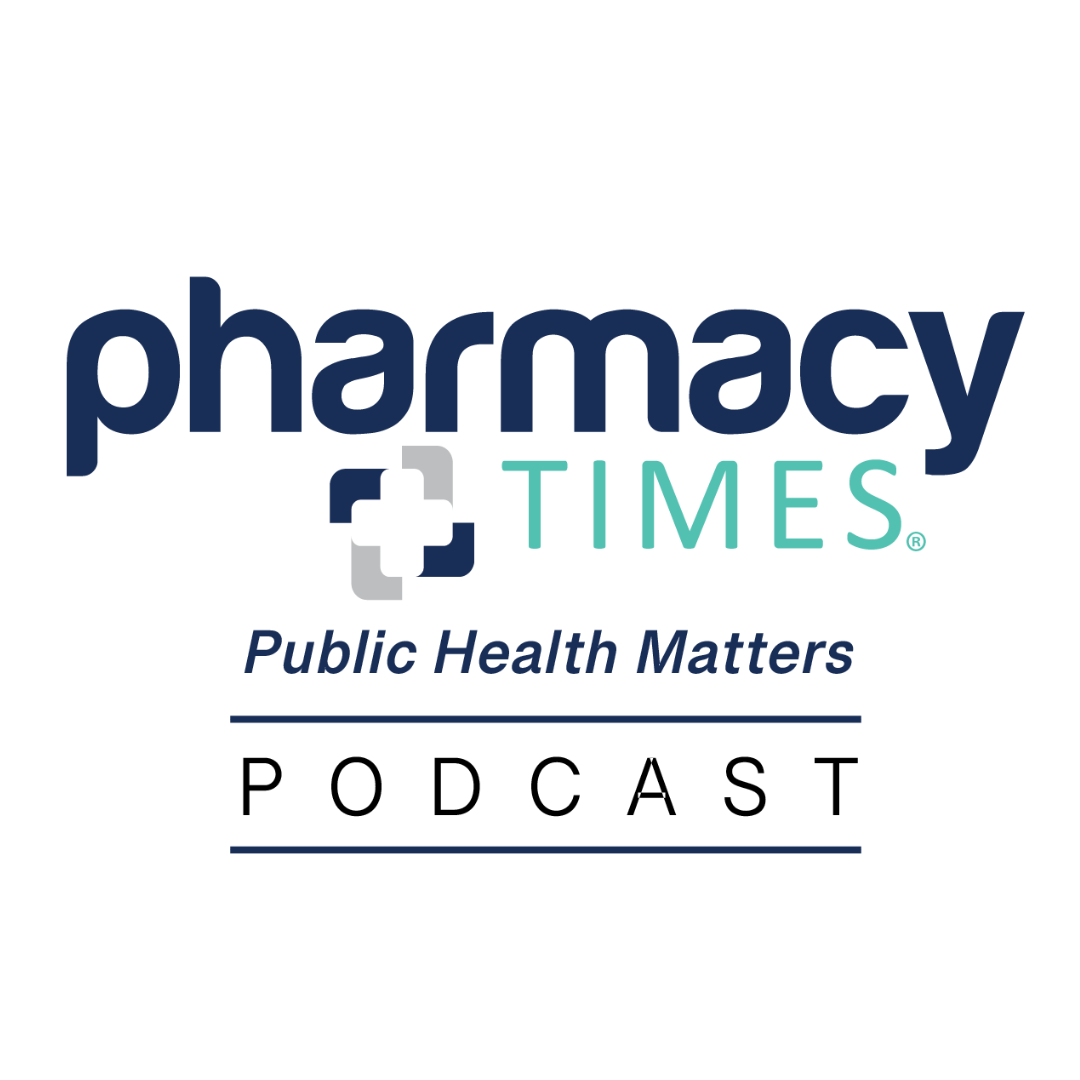
Public Health Matters: The Difference Between Misinformation and Disinformation, and How Information Can Inform Evidence-Based Decisions

Study Shows Shingles Infection Could Be Associated With Dementia
Public Health Matters: Healthcare Advocate Summit Emphasizes Advocates Have a Voice in Creating Solutions

FDA Adds Delayed Gastric Emptying as Adverse Event on Semaglutide Label

AHA 2024: GLP-1, SGLT2 Treatments May Lower Risk of Future Heart Attack, Stroke for Stroke Survivors
2 Commerce Drive Cranbury, NJ 08512
609-716-7777

Pharmacy Case Studies for Pharmacists & Medical Sciences Students
Pharmacists and healthcare practitioners are required to demonstrate knowledge and understanding of the application of therapeutics in clinical practice. Pharmacists must ensure patient safety and achieve desired health outcomes through effective decision-making. The idea of designing these case studies is to meet the needs and challenges of a modern pharmacy undergraduate curriculum. Case studies are increasingly used in pharmacy undergraduate as well as postgraduate education.
Each chapter contains five case studies, increasing in complexity from those we would expect first-year students to complete (Level 1) through to cases designed for fourth-year/pre-registration students (Level M). The chapters have been designed to follow approximately the British National Formulary chapters for ease of use. Case study scenarios include both community and hospital pharmacy situations as suited to the disease and pharmaceutical care provision.
This section is only for Bangladeshi Pharmacy/Medical Students & Professionals !
Cardiovascular case studies by Narinder Bhalla
Case study level 1 – Angina Case study level 2 – Hypertension Case study level 3 – Atrial fibrillation Case study level Ma – Heart failure Case study level Mb – Myocardial infarction
Respiratory system case studies by Soraya Dhillon and Andrzej Kostrzewski
Case study level 1 – Asthma – community Case study level 2 – Asthma – acute on chronic Case study level 3 – Chronic obstructive pulmonary disease (COPD) with co-morbidity Case study level Ma – COPD Case study level Mb – Brittle asthma
Obstetrics, gynaecology and UTI case studies by Alka Mistry
Case study level 1 – Primary dysmenorrhoea Case study level 2 – Urinary tract infections in pregnancy Case study level 3 – Pelvic inflammatory disease Case study level Ma – Endometriosis management in secondary care Case study level Mb – Management of severe pre-eclampsia/ eclampsia
Liver disease case studies by Caron Weeks and Mark Tomlin
Case study level 1 – Alcoholic cirrhosis; alcohol withdrawal Case study level 2 – Alcoholic cirrhosis; management of bleeding risk and treatment for the maintenance of alcohol abstinence Case study level 3 – Hepatic encephalopathy and ascites Case study level Ma – Pulmonary tuberculosis Case study level Mb – Liver failure
- Case study for pharmacist
- Pharmacy case study
You might be interested in
Liver disease case studies: Case study level 1 – Alcoholic cirrhosis; alcohol withdrawal
Cardiovascular case studies: case study level mb – myocardial infarction, cardiovascular case studies : case study level 3 – atrial fibrillation.
Nice sources
How to read all case studies?
Leave a Reply Cancel reply
Your email address will not be published.
{{#message}}{{{message}}}{{/message}}{{^message}}Your submission failed. The server responded with {{status_text}} (code {{status_code}}). Please contact the developer of this form processor to improve this message. Learn More {{/message}}
{{#message}}{{{message}}}{{/message}}{{^message}}It appears your submission was successful. Even though the server responded OK, it is possible the submission was not processed. Please contact the developer of this form processor to improve this message. Learn More {{/message}}
Submitting…
This site uses Akismet to reduce spam. Learn how your comment data is processed .

Press Release: 4 Symposiums at BioPharma Asia Convention 2013, Singapore
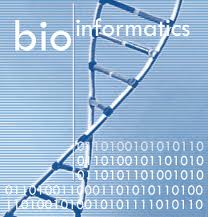
Notes on Bioinformatics Basic
Latest from blog.

Why Nitrile Exam Gloves Are the Preferred Choice for Medical Professionals

CDMOs: Shaping The Future of Pharmaceutical Innovation

The Crucial Role of Pharmaceutical Impurity Reference Standards in Quality Control

Tailor-made Solution for Collagenase

Restructuring for Resilience: How Biotech Leaders Can Navigate the New Landscape

- Enquire now
Supporting health professionals
- Sectors Overview
Choose your sector to find out how
- Community Pharmacy
- Healthcare and Hospital
- Pharmaceutical Industry
Sector Latest

Introducing Psychotropic Drug Directory
Psychotropic Drug Directory supports the optimal and rational use of medicines, to improve the quality of life for people with mental health needs.
Knowledge products
- Knowledge Products Overview
Point of Need
- Agilio: Diagnosis and Treatment Guidance
- BNF for Children
- Drug Compatibility Checker
- Drug Monitoring Checker
- Palliative Care Formulary
- Martindale’s ADR Checker
- Stockley’s Drug Interactions
- Stockley’s Interactions Checker
- Critical Illness
- Drugs in Pregnancy and Lactation
- Psychotropic Drug Directory
Drug Administration
- ASHP Injectable Drug Information
- Drug Administration via Enteral Feeding Tubes
- Extended Stability for Parenteral Drugs
- Injectable Drugs Guide
- Pediatric Injectable Drugs
- AHFS Drug Information
- Clarke’s Analysis of Drugs and Poisons
- Electronic Medicines Compendium (emc)
- Kucer’s the Use of Antibiotics
- Martindale: The Complete Drug Reference
- Pharmaceutical Excipients
Complementary and Alternative Medicine
- Dietary Supplements
- Herbal Medicines
- Stockley’s Herbal Medicines Interactions

Legal and Regulatory
- Dale and Appelbe’s Pharmacy and Medicines Law
- The MHRA Orange Guide
- The MHRA Green Guide
- Pharmaceutical Journal
- Research Journals
Discover our core services
Learn more about, services latest.

Book a demonstration today
Contact our team to see how our services can directly help you.
Resources and training
Access our free resources, latest resource.
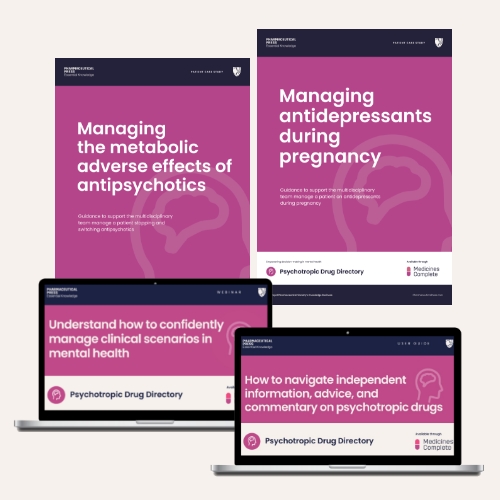
Access our Psychotropic Drug Directory user resources
Access our useful resources today to help your organisation realise the benefits of subscribing to Psychotropic Drug Directory through MedicinesComplete. Including patient case studies covering everyday clinical scenarios, and an on-demand webinar showing how to navigate independent information, advice, and commentary on psychotropic drugs.
The Royal Pharmaceutical Society’s Knowledge Business
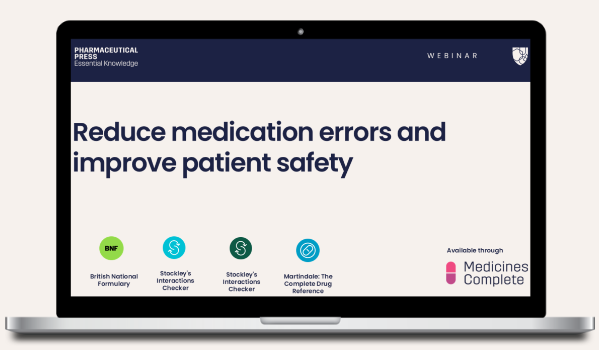
Reduce medication errors and improve patient safety
Register for this webinar to learn how MedicinesComplete can support you in implementing effective processes to reduce medication errors and improve patient safety.
Contact our expert team
Get in touch, information for, latest news.

Common mental health medications
Learn more about common mental health medications in our article.
- My Account dashboard
Log in to our essential knowledge
Go direct to:
- MedicinesComplete
- Pharmacy Knowledge Student
- Pharmacy Knowledge ONtrack
Patient case studies
Use our patient case studies, covering a wide range of everyday clinical scenarios, to learn how essential knowledge on MedicinesComplete supports decision-making at the point of need.
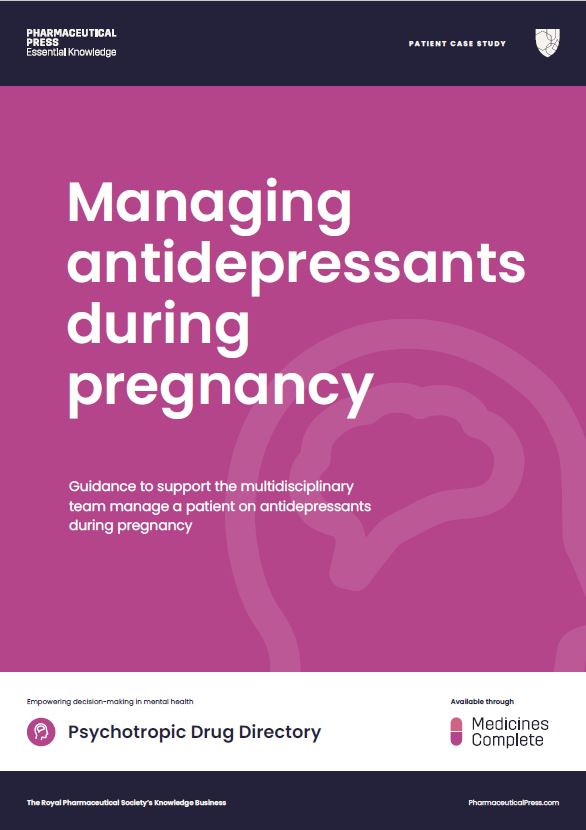
January 2024
Managing antidepressants during pregnancy
Guidance to support the multidisciplinary team manage a patient on antidepressants during pregnancy
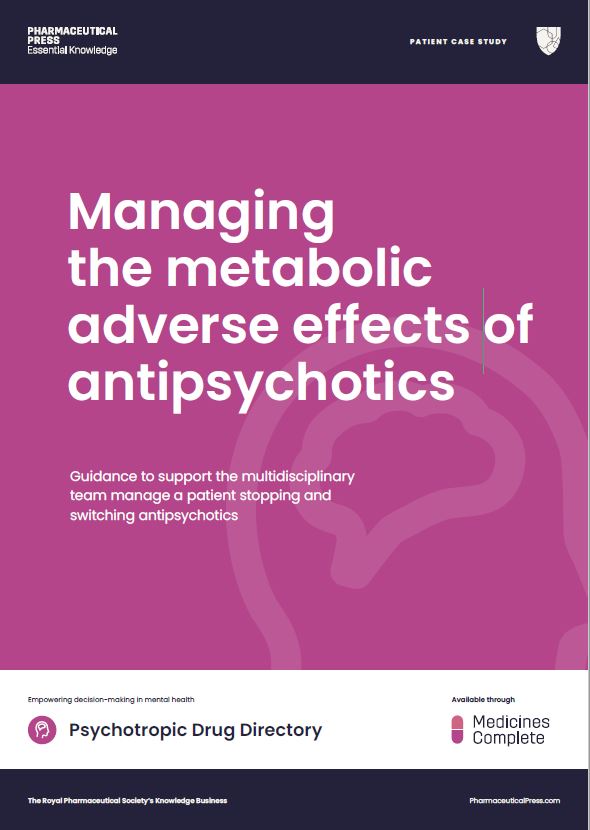
Managing the metabolic adverse effects of antipsychotics
Guidance to support the multidisciplinary team manage a patient stopping and switching antipsychotics.
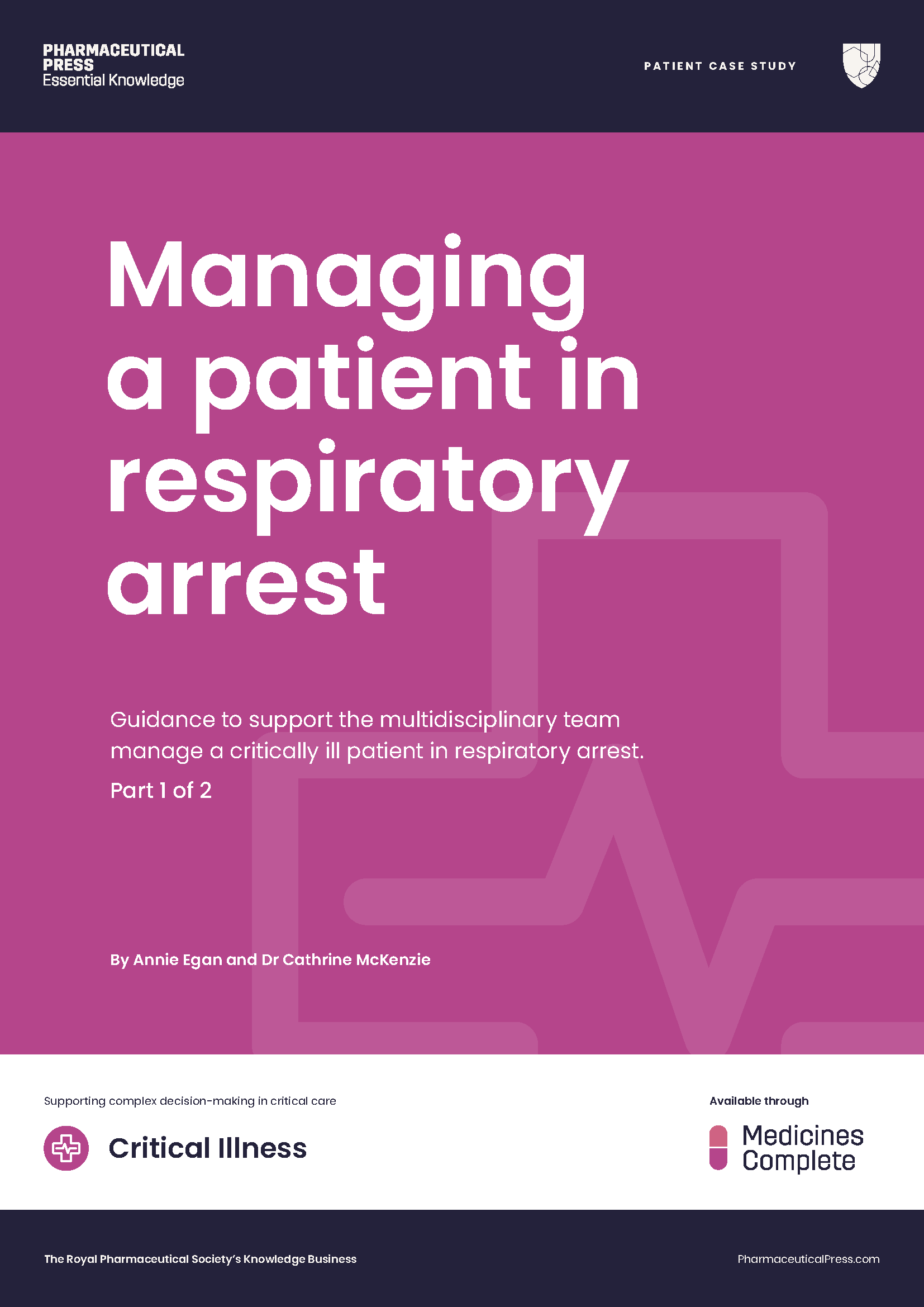
October 2023
Managing a patient in respiratory arrest
Guidance to support the multidisciplinary team manage a critically ill patient in respiratory arrest.
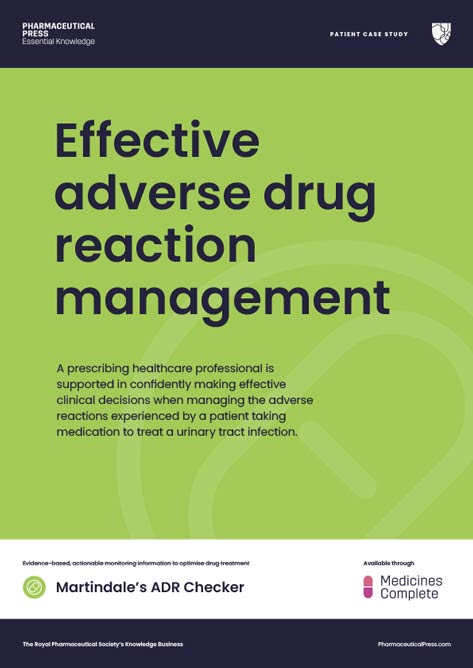
Effective adverse drug reaction management
A prescribing health professional is supported in confidently making effective clinical decisions when managing the adverse reactions experienced…
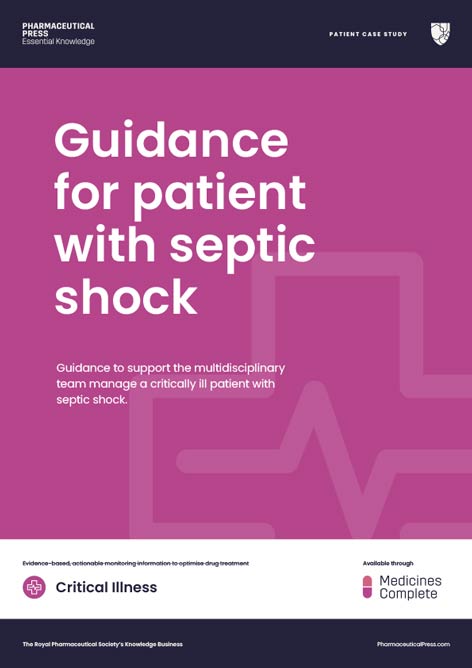
Guidance for patient with septic shock
Guidance to support the multidisciplinary team manage a critically ill patient with septic shock.
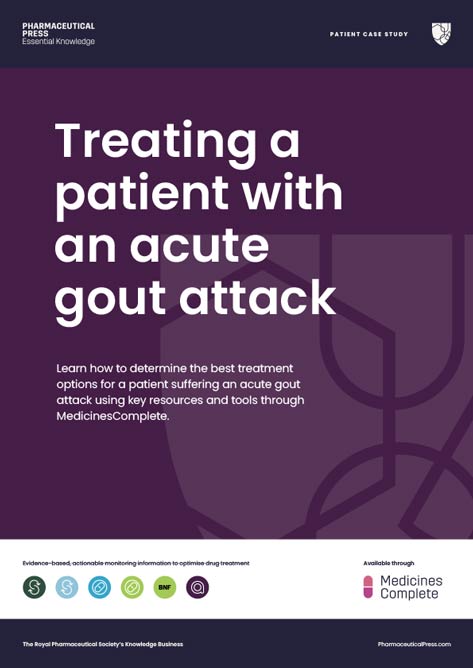
Treating a patient with an acute gout attack
Learn how to determine the best treatment options for a patient suffering an acute gout attack using knowledge…
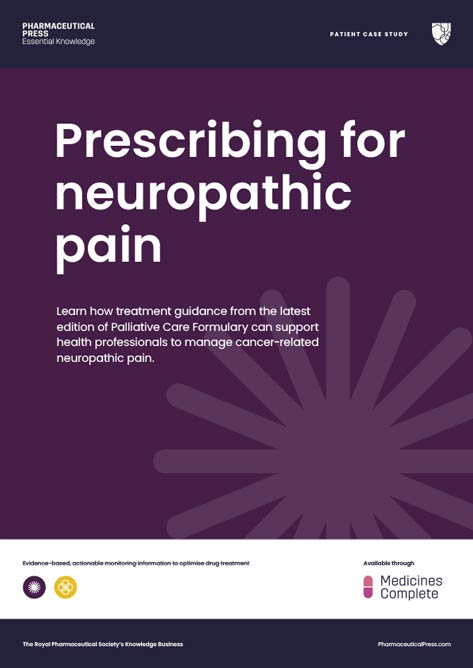
Prescribing for neuropathic pain
Learn how treatment guidance from the latest edition of Palliative Care Formulary can support health professionals to manage…
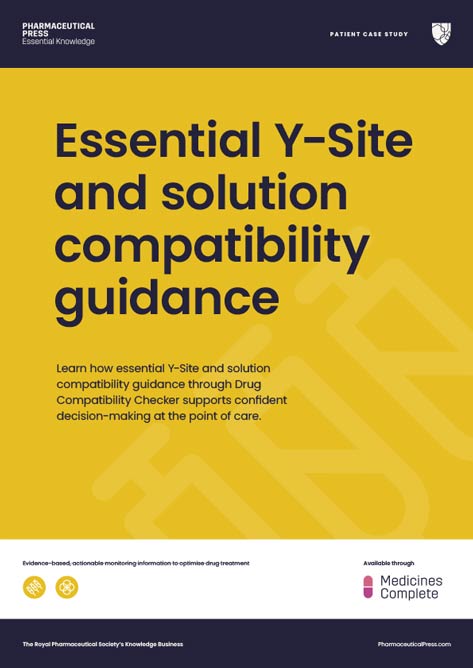
Essential Y-Site and solution compatibility guidance to support confident decision-making
Learn how health professionals can leverage the comprehensive capabilities of Drug Compatibility Checker, along with other knowledge products…
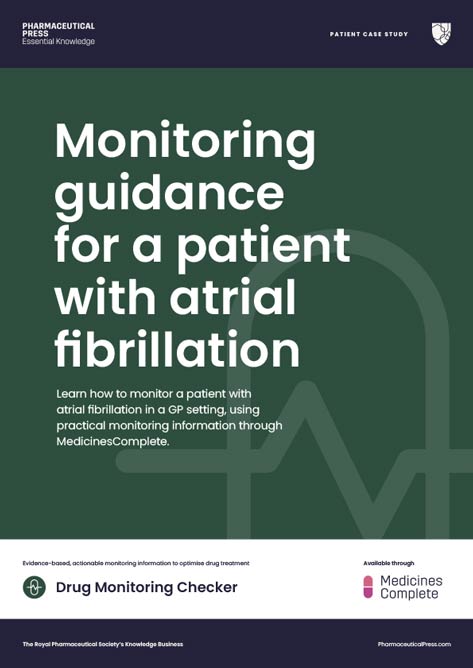
Monitoring guidance for a patient with atrial fibrillation
Learn how to monitor a patient with atrial fibrillation in a GP setting, using practical monitoring information on…
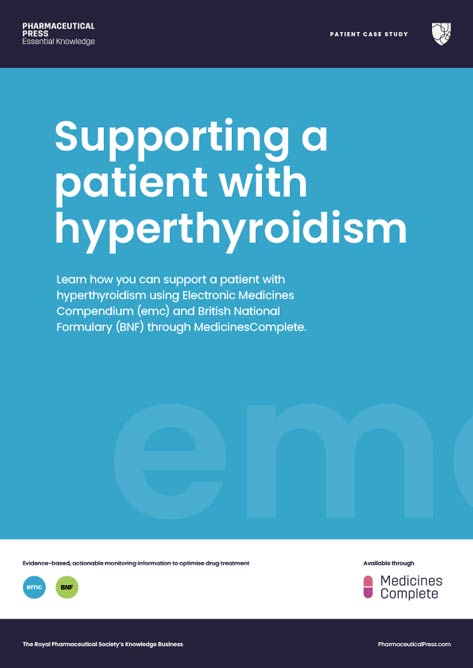
February 2022
Supporting a patient with hyperthyroidism
Learn how you can support a patient with hyperthyroidism using Electronic Medicines Compendium (emc) and British National Formulary (BNF)…
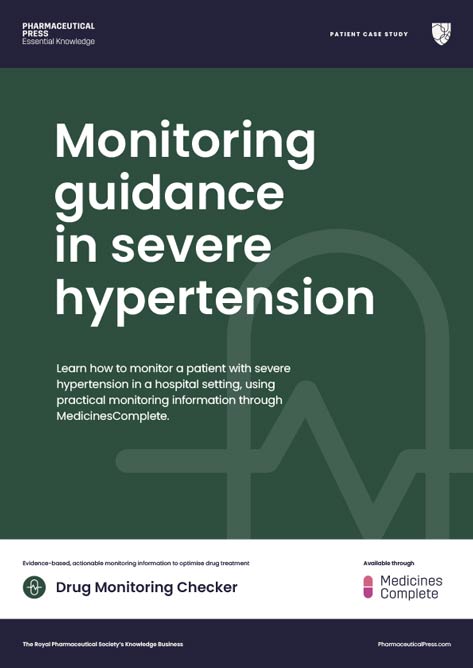
December 2021
Monitoring guidance in severe hypertension
Learn how to monitor a patient with severe hypertension in a hospital setting, using practical monitoring information on…
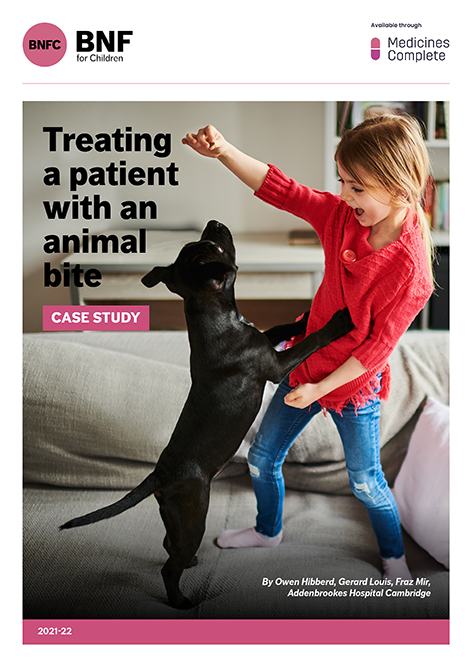
September 2021
Treating a patient with an animal bite
Learn how to determine the best treatment options for a child with an animal bite using BNF for…
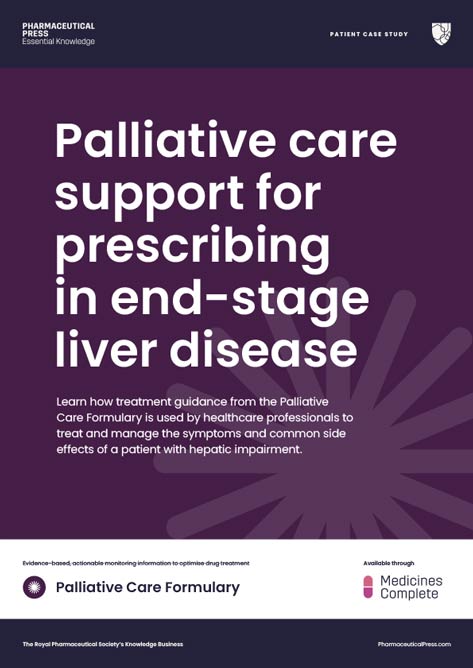
Palliative care support for prescribing in end-stage liver disease
Learn how treatment guidance from the Palliative Care Formulary is used by health professionals to treat and manage…
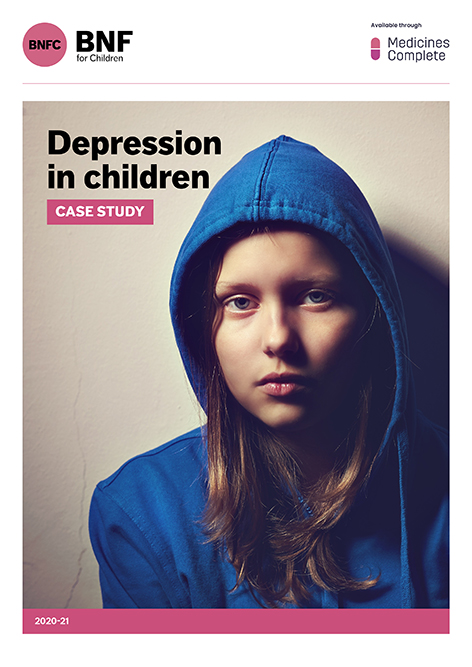
Determining the best treatment options for children and adolescents with depression
Learn how to determine the best treatment options for a teenage patient suffering with depression using BNF for…
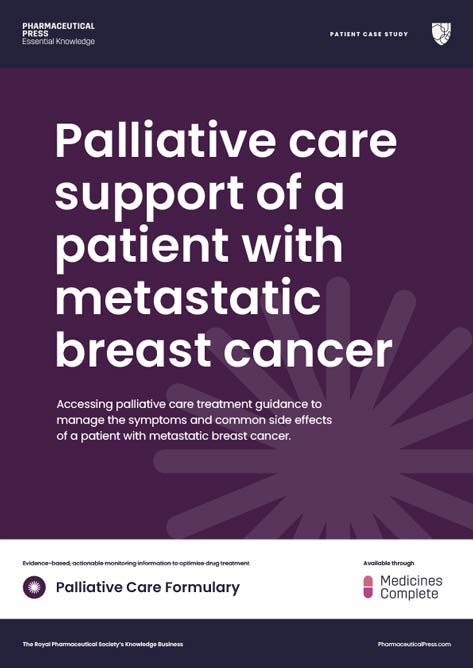
September 2019
Palliative Care support for the treatment of a patient with metastatic breast cancer
Accessing palliative care treatment guidance to manage the symptoms and common side effects of a patient with metastatic…
Access the essential knowledge you need today

Instant online access to our essential knowledge 24/7
Book a demo

The Royal Pharmaceutical Society’s official journal

Trusted knowledge and revision for tomorrow's pharmacists

High impact research in pharmaceutical sciences
- Access Provided by: Googlebot
- Sign in or Create a Free Access Profile
- Remote Access
- Save figures into PowerPoint
- Download tables as PDFs
Top 125 Drug Card Case Quiz
- Katzung Pharmacology Cases
- Pharmacotherapy Casebook and Care Plans
- Standardized Patient Cases
- Pharmacogenomics: A Primer for Clinicians
- Transitions of Care in Pharmacy Casebook
- Pharmacy Practice and Tort Law
- Case Files®: Pharmacology
- G&G Pharm Cases
- Pathophysiology Cases
- Infectious Diseases: A Case Study Approach
- Harrison’s Visual Case Challenge

Author(s): Jill M. Kolesar, PharmD, MS, BCPS, FCCP; Lee C. Vermeulen, BSPharm, MS, FCCP, FFIP
- 001 Case 001-Surgical Care
- 002 Case 002-Hypertension Case # 1
- 003 Case 003-Hypertension Case # 2
- 004 Case 004-Hypertension Case # 3
- 005 Case 005-Hypertension Case # 4
- 006 Case 006-Hypertension Case # 5
- 007 Case 007-Dyslipidemia Case # 1
- 008 Case 008-Dyslipidemia Case # 2
- 009 Case 009-Stable Ischemic Heart Disease
- 010 Case 010-Acute Coronary Syndromes
- 011 Case 011-Cardiovascular Respiratory Decompensation
- 012 Case 012-Chronic Heart Failure Case # 1
- 013 Case 013-Chronic Heart Failure Case # 2
- 014 Case 014-Venous Thromboembolism-Pulmonary Embolism Case # 1
- 015 Case 015-Venous Thromboembolism-Pulmonary Embolism Case # 2
- 016 Case 016-Stroke
- 017 Case 017-Arrhythmias
- 018 Case 018-Cardiac Arrest, Resuscitation
- 019 Case 019-Acne and Pediatric Dermatology Disorders
- 020 Case 020-Psoriasis
- 021 Case 021-Atopic Dermatitis
- 022 Case 022-Miscellaneous Dermatology
- 023 Case 023-Peptic Ulcer Disease, GERD Case # 1
- 024 Case 024-Peptic Ulcer Disease, GERD Case # 2
- 025 Case 025-Irritable Bowel Syndrome
- 026 Case 026-Diarrhea
- 027 Case 027-Constipation
- 028 Case 028-Crohn Disease
- 029 Case 029-Anemia
- 030 Case 030-CNS Infections
- 031 Case 031-Lower Respiratory Tract Infection
- 032 Case 032-Upper Respiratory Tract Infection
- 033 Case 033-Skin and Soft-Tissue Infections; Fungal (Multiple Patient Case)
- 034 Case 034-Infective Endocarditis
- 035 Case 035-Gastrointestinal Infections
- 036 Case 036-Intra-Abdominal Infections
- 037 Case 037-Urinary Tract Infection
- 038 Case 038-Skin and Soft Tissue Infection (Bacterial), Bone and Joint Infections
- 039 Case 039-Miscellaneous Bacterial Infections
- 040 Case 040-Sexually Transmitted Infections
- 041 Case 041-Sepsis and Septic Shock
- 042 Case 042-Fungal Infections Case # 1
- 043 Case 043-Fungal Infections Case # 2
- 044 Case 044-Viral Infections
- 045 Case 045-Parasitic Infections
- 046 Case 046-Infectious Endocarditis
- 047 Case 047-Viral Hepatitis, Hepatitis Vaccination
- 048 Case 048-Influenza and Influenza Vaccination (Multiple Patient Case)
- 049 Case 049-Foot and Nail Fungal Infection
- 050 Case 050-Vaccines Case # 1
- 051 Case 051-Vaccines Case # 2
- 052 Case 052-Travel Health (Multiple Patient Case)
- 053 Case 053-Human Immunodeficiency Virus Infection
- 054 Case 054-Systemic Lupus Erythematosus
- 055 Case 055-Solid Organ Transplantation
- 056 Case 056-Erectile Dysfunction
- 057 Case 057-Benign Prostatic Hyperplasia
- 058 Case 058-Attention Deficit Hyperactivity Disorder
- 059 Case 059-Substance Use Disorders (Opioids)
- 060 Case 060-Substance-Related Disorders (Alcohol, Nicotine)
- 061 Case 061-Schizophrenia
- 062 Case 062-Depression Case # 1
- 063 Case 063-Depression Case # 2
- 064 Case 064-Panic Disorder
- 065 Case 065-Bipolar Disorder
- 066 Case 066-Anxiety Disorders Case # 1
- 067 Case 067-Anxiety Disorders Case # 2
- 068 Case 068-Sleep-Wake Disorders
- 069 Case 069-Diabetes Mellitus (Type 2) Case # 1
- 070 Case 070-Diabetes Mellitus (Type 2) Case # 2
- 071 Case 071-Diabetes Mellitus (Type 2) Case # 3
- 072 Case 072-Thyroid Disorders
- 073 Case 073-Obesity
- 074 Case 074-Migraine Headache
- 075 Case 075-Critical Care Pain, Agitation, Delirium
- 076 Case 076-Alzheimer Disease
- 077 Case 077-Multiple Sclerosis
- 078 Case 078-Epilepsy Case # 1
- 079 Case 079-Epilepsy Case # 2
- 080 Case 080-Parkinson Disease
- 081 Case 081-Pain Management Case # 1
- 082 Case 082-Pain Management Case # 2
- 083 Case 083-Pain Management Case # 3
- 084 Case 084-Brain Cancer
- 085 Case 085-Breast Cancer
- 086 Case 086-Lung Cancer
- 087 Case 087-Colorectal Cancer
- 088 Case 088-Prostate Cancer
- 089 Case 089-Hodgkin Lymphoma
- 090 Case 090-Lymphoma
- 091 Case 091-Acute Myeloid Leukemia
- 092 Case 092-Chronic Lymphocytic Leukemia
- 093 Case 093-Multiple Myeloma
- 094 Case 094-Myelodysplastic Syndrome
- 095 Case 095-Renal Cell Cancer
- 096 Case 096-Melanoma
- 097 Case 097-Ovarian Cancer
- 098 Case 098-Chemotherapy-Induced Emesis
- 099 Case 099-Cancer Pain
- 100 Case 100-Stem Cell Transplant
- 101 Case 101-Idiopathic Thrombocytopenic Purpura, Thrombotic Thrombocytopenic Purpura
- 102 Case 102-Glaucoma
- 103 Case 103-Bacterial Conjunctivitis
- 104 Case 104-Allergic Conjunctivitis
- 105 Case 105-Asthma Case # 1
- 106 Case 106-Asthma Case # 2
- 107 Case 107-Allergic Rhinitis Case # 1
- 108 Case 108-Allergic Rhinitis Case # 2
- 109 Case 109-Chronic Obstructive Pulmonary Disease
- 110 Case 110-Osteoarthritis
- 111 Case 111-Rheumatoid Arthritis
- 112 Case 112-Osteoporosis
- 113 Case 113-Gout
- 114 Case 114-Urinary Disorders – Male
- 115 Case 115-Urinary Disorders – Female
- 116 Case 116-Menopause Care
- 117 Case 117-Menstruation-Related Disorders
- 118 Case 118-Contraception
- 119 Case 119-Obstetric Care
- 120 Case 120-Family Medicine Case # 1 (Multiple Patient Case)
- 121 Case 121-Family Medicine Case # 2 (Multiple Patient Case)
- 122 Case 122-Family Medicine Case # 3 (Multiple Patient Case)
- 123 Case 123-Family Medicine Case # 4 (Multiple Patient Case)
- 124 Case 124-Family Medicine Case # 5 (Multiple Patient Case)
- 125 Case 125-Family Medicine Case # 6 (Multiple Patient Case)
- Recommended
- Recently Viewed
- Collections
- Review Questions
- Create a Free Profile

COMMENTS
î 3dwlhqw ,qirupdwlrq 'hprjudsklfv djh udfh vh[ 5hylhz ri 6\vwhpv 526 shuwlqhqw srvlwlyhv qhjdwlyhv &klhi &rpsodlqw && 3k\vlfdo ([dplqdwlrq 3( lqfoxglqj
CASE 1: NS is a 55-year-old man who recently visited his primary-care provider (PCP) for a follow up. His medical history includes hypothyroidism, hypertension, and type 2 diabetes (T2D). He takes levothyroxine 75 mcg daily, lisinopril 20 mg daily, and metformin 1 gram twice a day.
Practice More Pharmacy Case Studies. The more pharmacy case studies you practice, the better prepared you are for the needs and demands that present during the licensing end of your pharmacy program. Pharmacy case studies help guide students through the must-know clinical facts about drugs and medicines; both theoretical and practical knowledge.
Case 1. EP is a patient with epilepsy. He has been taking phenytoin at a therapeutic dose for 4 years. EP was recently prescribed valproic acid because he has had breakthrough seizures over the past few months. After taking valproic acid for several days, he calls the pharmacy expressing concern about some new adverse effects.
This article is part 5 of a 6-part series on interesting and unusual medication-related case reports. For part 4 click here. Case reports are defined as the scientific documentation of an individual patient. These reports are often written to document an unusual clinical presentation, treatment approach, side effect, or response to treatment.
Beginning a patient presentation • Start by introducing the patient. • Ex. JP is a 48 year old female… • Explain why the patient was admitted. • Ex. JP is a 48 year old female who presented to the emergency room with respiratory distress. • Give a brief summary of the patient's background and pertinent history. • Ex. JP is a 48 year old female who presented to the emergency
Pharmacists and healthcare practitioners are required to demonstrate knowledge and understanding of the application of therapeutics in clinical practice. Pharmacists must ensure patient safety and achieve desired health outcomes through effective decision-making. The idea of designing these case studies is to meet the needs and challenges of a modern pharmacy undergraduate curriculum. Case ...
Pharmacy Knowledge Trusted knowledge and revision for tomorrow's pharmacists; Content Licensing and Integration ... Including patient case studies covering everyday clinical scenarios, and an on-demand webinar showing how to navigate independent information, advice, and commentary on psychotropic drugs. ...
Standardized Patient Cases ... Infectious Diseases: A Case Study Approach Harrison's Visual Case Challenge Top 125 Drug Card Case Quiz. Author(s): Jill M. Kolesar, PharmD, MS, BCPS, FCCP; Lee C. Vermeulen, BSPharm ... 052 Case 052-Travel Health (Multiple Patient Case)
Learn how pharmacy professionals at hospitals and health-systems across the country successfully implemented PAI 2030's recommendations to advance patient care. Submit Your Case Study Here Share how your practice site is implementing one or more of the PAI 2030 recommendations .